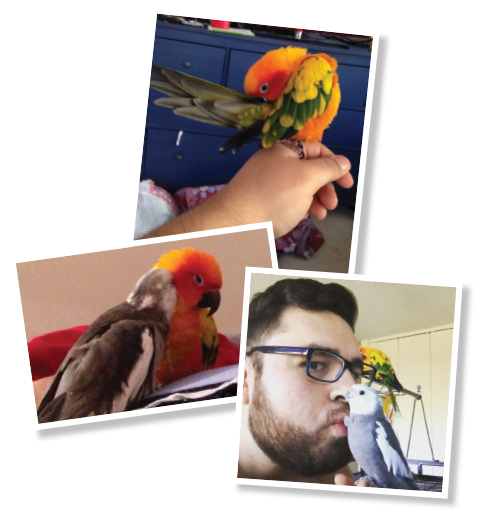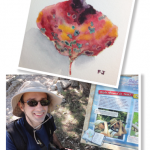Excluding the years he spent in medical school, Jonathan Paramo, MD, has always kept birds as pets. As an animal lover, he believes he shares a special chemistry with birds, specifically any species of parrots. When he’s around them, he says he experiences “a special feeling.”
“There are cat lovers and dog lovers, but you don’t find many bird lovers,” he says. “But we’re out there and a little bit unique and strange. I feel we’re a special kind of people because birds understand us and we understand them.”
Childhood Pets
When Dr. Paramo was 13 years old, he had formed a strong bond with his cousin’s pet—a vibrant, orange and yellow lovebird named Chuchupa. When his cousin could no longer care for the bird, Dr. Paramo brought the bird, a member of the parrot family, home with him.
At the time, young Jonathan lived in Miami with his family. They had recently adopted a stray dog. The dog constantly tried to snatch the bird out of the air when she flew around the house, succeeding in its hunt one evening when the family was in another room.
“I was definitely broken-hearted,” recalls Dr. Paramo, now a rheumatology fellow at Zucker School of Medicine at Hofstra/Northwell, Hempstead, N.Y. “I had the bird for several years. At 13, I never really thought Chuchupa was in danger [from the dog].”
A friendly cockatiel was the next addition to the family. While some birds attach to one person, Dr. Paramo says this bird was very outgoing and attached to multiple people. However, his father believed birds should be free, not kept in cages or people’s homes, and released the cockatiel into the wild.
“I had this bird for two years before my dad released it,” he says, adding that cockatiels survive in flocks and typically live for 20 years. “I was very upset about it, but hopeful that maybe I would find him nearby in a tree or that someone would come to me and say, ‘I found your bird.’ But I never saw him again.”
‘[Bird lovers are] a special kind of people because birds understand us & we understand them.’
Despite these traumatic childhood experiences, Dr. Paramo was determined to have birds as pets. While still a teenager, he purchased two, yellow and orange parakeets. Now a more experienced pet owner, he loved and cared for these birds like some teenage boys care for their cherished cars. However, both birds eventually died of an undiagnosed illness.
New Roommates

Top: Sol, preening her feathers. Middle: Casper helps Sol straighten and clean her feathers. Bottom: Dr. Paramo kisses Casper, his favorite cockatiel.
While attending Rutgers New Jersey Medical School, Newark, N.J., Dr. Paramo couldn’t have any pets due to his grueling academic and work schedule. But by his fourth year of medical school, he realized the important social role parrots had played in his life. So he purchased a gray and white male cockatiel he called Casper, and a yellow and orange female conure, a
medium-sized parrot, he named Sol.
Life was good.
Dr. Paramo graduated medical school in 2015 and completed his three-year residency at Zucker School of Medicine in 2018. He’ll finish his two-year rheumatology fellowship at the same university in June 2020.
“I decided early in medical school that I didn’t want to concentrate on one organ system,” he says. “I also tended to like outpatient more than inpatient care. I chose rheumatology because it’s a multi-system specialty that’s outpatient, is more patient-oriented than other fields, has patient continuity and introduces innovations based on current research.”
Love ’em or Leave ’em
Casper and Sol, who are now five years old, are an important part of Dr. Paramo’s family. Just like some people, he says these birds have “clownish” personality traits and are very social animals.
Sol, for example, enjoys being petted on her head or chest and will eat nearly anything, especially vegetables, mangos, dried fruits and chicken bones. Not Casper. He prefers sitting on or near someone and is very picky when it comes to food. He actually becomes irritated or angry if you try feeding him something he doesn’t enjoy. Sol loves coffee, which is a big no-no for birds if it contains milk or cream, while Dr. Paramo says Casper “goes crazy” over rice and won’t stop eating until you take it away from him.
They do share some traits. Both are troublemakers, Dr. Paramo says. Sometimes, Casper pokes small holes on the top of the wooden doors at Dr. Paramo’s home, so a barrier of some kind, like a small towel, must be placed on each door. Both birds also try to bite electrical cords and are extremely scared of stuffed animals.
As for Sol, well, she screams—a lot. “Generations back, when Sol’s ancestors lived in the wild, they communicated with each other by screaming,” Dr. Paramo says.
Unsurprisingly, Dr. Paramo’s least favorite activity is cleaning out messy bird cages. Sometimes, he says, it can take several hours.
Still, Dr. Paramo wouldn’t trade his beloved birds for any dog or cat, no matter how well behaved. He says parrots bond with humans for life, make excellent companions and sometimes perform special mating dances that are unique to each
species. Casper sings beautiful melodies and at times, can be “hilarious,” he says, when mimicking people’s laughter.
“They’re just amazing, beautiful creatures overall,” Dr. Paramo says, adding that just being around them takes the edge off a hard workday. “That’s why I’m so obsessed with them.”
Dr. Paramo does have a warning for potential bird owners: “If people aren’t ready, a lot of them can’t handle birds, and the birds end up homeless. They’re not starter pets.”
Carol Patton, a freelance writer based in Las Vegas, Nev., writes the Rheum after 5 column for The Rheumatologist.


